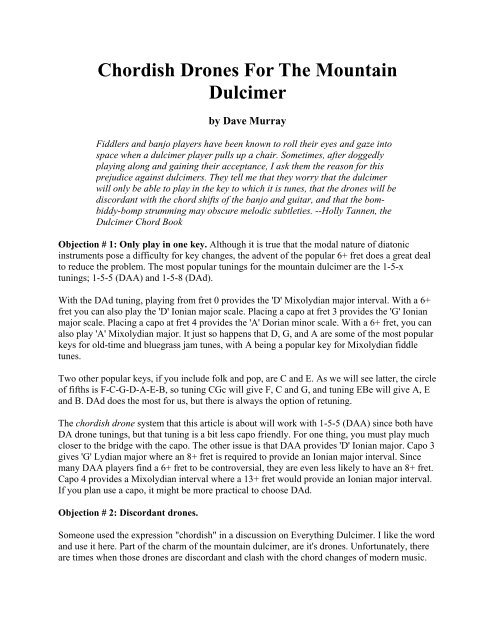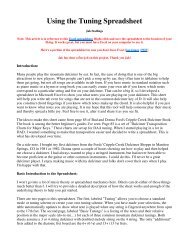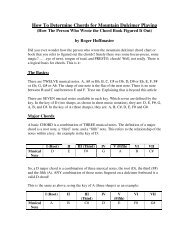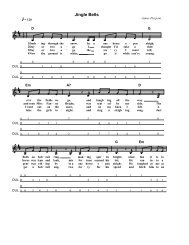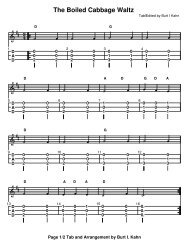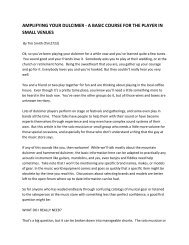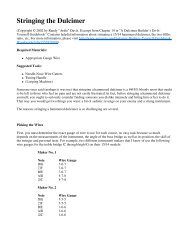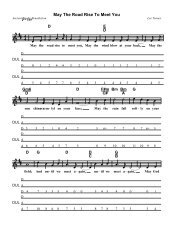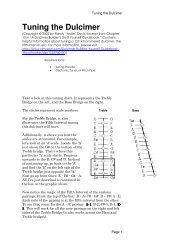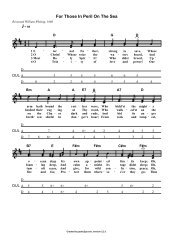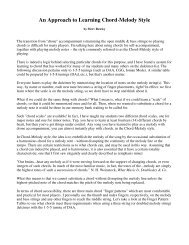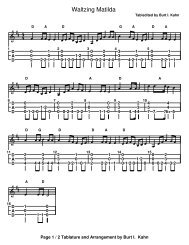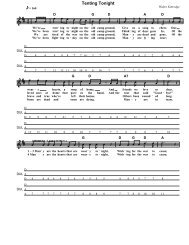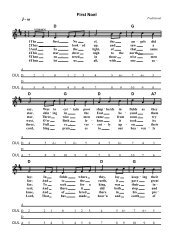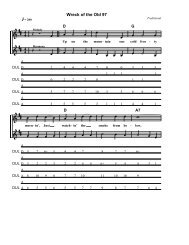Create successful ePaper yourself
Turn your PDF publications into a flip-book with our unique Google optimized e-Paper software.
<strong>Chordish</strong> <strong>Drones</strong> <strong>For</strong> <strong>The</strong> <strong>Mountain</strong><strong>Dulcimer</strong>by Dave MurrayFiddlers and banjo players have been known to roll their eyes and gaze intospace when a dulcimer player pulls up a chair. Sometimes, after doggedlyplaying along and gaining their acceptance, I ask them the reason for thisprejudice against dulcimers. <strong>The</strong>y tell me that they worry that the dulcimerwill only be able to play in the key to which it is tunes, that the drones will bediscordant with the chord shifts of the banjo and guitar, and that the bombiddy-bompstrumming may obscure melodic subtleties. --Holly Tannen, the<strong>Dulcimer</strong> Chord BookObjection # 1: Only play in one key. Although it is true that the modal nature of diatonicinstruments pose a difficulty for key changes, the advent of the popular 6+ fret does a great dealto reduce the problem. <strong>The</strong> most popular tunings for the mountain dulcimer are the 1-5-xtunings; 1-5-5 (DAA) and 1-5-8 (DAd).With the DAd tuning, playing from fret 0 provides the 'D' Mixolydian major interval. With a 6+fret you can also play the 'D' Ionian major scale. Placing a capo at fret 3 provides the 'G' Ionianmajor scale. Placing a capo at fret 4 provides the 'A' Dorian minor scale. With a 6+ fret, you canalso play 'A' Mixolydian major. It just so happens that D, G, and A are some of the most popularkeys for old-time and bluegrass jam tunes, with A being a popular key for Mixolydian fiddletunes.Two other popular keys, if you include folk and pop, are C and E. As we will see latter, the circleof fifths is F-C-G-D-A-E-B, so tuning CGc will give F, C and G, and tuning EBe will give A, Eand B. DAd does the most for us, but there is always the option of retuning.<strong>The</strong> chordish drone system that this article is about will work with 1-5-5 (DAA) since both haveDA drone tunings, but that tuning is a bit less capo friendly. <strong>For</strong> one thing, you must play muchcloser to the bridge with the capo. <strong>The</strong> other issue is that DAA provides 'D' Ionian major. Capo 3gives 'G' Lydian major where an 8+ fret is required to provide an Ionian major interval. Sincemany DAA players find a 6+ fret to be controversial, they are even less likely to have an 8+ fret.Capo 4 provides a Mixolydian interval where a 13+ fret would provide an Ionian major interval.If you plan use a capo, it might be more practical to choose DAd.Objection # 2: Discordant drones.Someone used the expression "chordish" in a discussion on Everything <strong>Dulcimer</strong>. I like the wordand use it here. Part of the charm of the mountain dulcimer, are it's drones. Unfortunately, thereare times when those drones are discordant and clash with the chord changes of modern music.
<strong>The</strong>se are the times when we might like to be able to make a simple adjustment to the drones tomake them "fit in".This article is not about accompaniment chords, or finding the most elegant way to arrange asong. It is simply about finding a way to make those charming drones sound harmonious.A small amount of very basic theory is included. No doubt, every musician who plays themountain dulcimer already knows it. Many people who play the mountain dulcimer are notmusicians and roll their eyes at the mention of theory, and don't know it. I highly recommendthat you not skip it since it is helpful. <strong>The</strong>re is a reason why musicians learn the basics of musictheory. If after you read it, it's not your thing to "study", fine, at least you'll understand the logicof this approach. I promise, it is only a small amount of very basic theory.Objection # 3: Only play one rhythm.This article does not address that issue. It is a topic that sorely needs a good article by someonequalified to write it.Chord Basics<strong>The</strong> most basic chords are also known as triads because they are made up of three notes with aspecific interval. A major chord has a root, a note two whole steps above it, and a note one and ahalf steps above that. A minor chord has a root, a note one and a half steps above it, and anothernote two whole steps above that. Something that they have in common is that the first and thirdnote for both chords are the same. <strong>The</strong>y are an interval known as the one-five.A chord is often extended to a seven chord (I7, IV7, V7, etc). This means that the seventhdegree is added to the chord. <strong>The</strong>re are Major and natural seventh chords, with the naturalseventh being more common (and pleasing in most cases). <strong>The</strong> major seventh has the fourth notetwo whole steps above the third note (5th), while the natural seventh has the fourth note one anda half steps above the third note (5th).Major chords have a relative minor chord. <strong>The</strong> circle of fifths section that follows shows aneasy way to determine what it is.Inverted chords do not have the root note as the lowest note. <strong>The</strong>re's more to it than that, butthat's enough about it for this discussion.<strong>The</strong> Circle Of FifthsG D A E B F# C#IV I V ii vi iii vii orel IV rel I rel V<strong>The</strong> table above shows the notes of the D Major scale as it appears on the circle of 5ths. Since itmoves by 5ths going CW (right), and by 4ths going CCW (left), one of the things that it shows is
what the IV and V chords are for a key. In the example, for the key of D, the G (IV) is to the leftand the A (V) is to the right. This gives us an easy reference when we change keys with a capo.Another thing it shows us is the relative minors. Just move three steps CW (right) to find therelative minor. D G A E indicates that the relative minor of D is E.<strong>Chordish</strong> <strong>Drones</strong> With I-V-x TuningFour Drone Notes, Key of D ExampleD (I) E F F# G G# A A# B C C# D D# E F F# G G# A A# B CEm (ii) E F F# G G# A A# B C C# D D# E F F# G G# A A# B CF#mE F F# G G# A A# B C C# D D# E F F# G G# A A# B C(iii)G (IV) E F F# G G# A A# B C C# D D# E F F# G G# A A# B CA (V) E F F# G G# A A# B C C# D D# E F F# G G# A A# B CBm (vi) E F F# G G# A A# B C C# D D# E F F# G G# A A# B Ckey Gcapo3DAx keys of G, D, and AIV I Vkey DIV I Vkey AIV Iii vi iiiii vi iiiii viC G D no G D A capo D AAm Em Bm capo Em Bm F#m 4 Bm F#mG G G A D D D E A A A BD C D D A G A A E D E EViiiEDbm<strong>The</strong> heart of the chordish drone concept is that we are not actually trying to create chords, butare creating drone intervals that are not discordant with the chord changes. <strong>The</strong> most commondrones are the root-5 of the I chord, but there is no law saying that that must be the case. <strong>The</strong>root, and octave of the root (D-d) for a D chord works quite well.<strong>The</strong> charts above show that in theory, we only need to change the pitch of one drone to get theroot-5 of the IV chord, and only need to change the other drone to make the root-5 of the Vchord. In some cases this will work for us, but due to the layout of the mountain dulcimer fretboard, some reachable areas of the fret board require us to fret two strings, inverting the drones.<strong>For</strong>tunately, when this is the case, they are generally adjacent, or separated by one fret, and aretherefore doable.<strong>The</strong> second key concept is that when minor chords are being played, we do not need to create aroot-5 interval of the minor chord. <strong>The</strong> most likely minor chords are relative minors of the I, IV,or V chord. Since the relative minor7 chord has the 3-5-7 of it's major, if we play the root-5 of
the I chord we are also playing the 3-7 of the relative minor chord. It does less to imply the chordsince it is missing the root, but most importantly, it will not be discordant. This simplifies thingsgreatly. If you are playing a song where IV chord is replaced by the vi chord, treat it like the Ichord. Example: B-D-F#-A works for D (D-F#-A) and Bm7 (B-D-F#-A).Note: <strong>The</strong> root-5 interval is neither major or minor, but the minor3-natural7 interval is veryminor. You can use the root-5 where the chord is either major or minor, but that is not the casewhen using the relative minor substitute.No Capo, Key Of DI (D) & vi (Bm) -- B-D-F#-AD E F# G A B C C# D E F# G A B C C# D EA B C# D E F# G G# A B C# D E F# GG# A B0 1 2 3 4 5 6 6+ 7 8 9 10 11 12 1313+ 14 15IV (G) & ii (Em) -- E-G-B-DD E F# G A B C C# D E F# G A B C C# D EA B C# D E F# G G# A B C# D E F# G G# A B0 1 2 3 4 5 6 6+ 7 8 9 10 11 12 1313+ 14 15V (A) & iii (F#m) -- F#-A-C#-ED E F# G A B C C# D E F# G A B C C# D EA B C# D E F# G G# A B C# D E F# GG# A B0 1 2 3 4 5 6 6+ 7 8 9 10 11 12 1313+ 14 15Capo 3, Key Of GI (G) & vi (Em) -- E-G-B-DD E F# G A B C C# D E F# G A B C C# D EA B C# D E F# G G# A B C# D E F# G G# A BNA NA NA 0 4 5 6 6+ 7 8 9 10 11 12 13 13+ 14 15IV (C) & ii (Am) -- A-C-E-GD E F# G A B C C# D E F# G A B C C# D E
A B C# D E F# G G# A B C# D E F# G G# A BNA NA NA 0 4 5 6 6+ 7 8 9 10 11 12 13 13+ 14 15V (D) & iii (Bm) -- B-D-F#-AD E F# G A B C C# D E F# G A BC C# D EA B C# D E F# G G# A B C# D E F# G G# A BNA NA NA 0 4 5 6 6+ 7 8 9 10 11 12 13 13+ 14 15Capo 4, Key Of AI (A) & vi (F#m) -- F#-A-C-ED E F# G A B C C# D E F# G A BC C# D EA B C# D E F# G G# A B C# D E F# G G# A BNA NA NANA 0 5 6 6+ 7 8 9 10 11 12 13 13+ 14 15IV (D) & iii (Bm) -- B-D-F#-AD E F# G A B C C# D E F# G A BC C# D EA B C# D E F# G G# A B C# D E F# G G# A BNA NA NANA 0 5 6 6+ 7 8 9 10 11 12 13 13+ 14 15V (E) & iii (Dbm) -- Db-E-G#-BD E F# G A B CC# D E F# G A B C C# D EA B C# D E F# G G# A B C# D E F# G G# A BNA NA NANA 0 5 6 6+ 7 8 9 10 11 12 13 13+ 14 15SummaryThis is a hybrid compromise system where we get all we can from the drones and do as little aspossible while eliminating dissonance with other players who are following the chord changes tocreate harmony.It provides a simple method for dealing with music that includes relative minor chords.It is a capo friendly system that allows us to play in multiple keys and facilitates retuning whilemaintaining a familiar fret layout with the same patterns.


